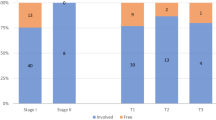Summary
308 cases of papillary thyroid carcinoma (82.6% of our patients operated on between 1952 and 1987) who had undergone potentially curative surgery were analysed postoperatively. The follow-up ranges from 1 month to 29.4 years (median 4.58 years). In 32 cases (10.4%) a cervical tumour recurrence (local recurrence and/or cervical lymph nodes) was found. 8 of these are not free of tumour at the end of the follow-up, 6 had died of thyroid carcinoma (case fatality rate 18.8%, mortality rate 66.7%, in the entire material 2.9% and 29.0% respectively). The cumulative recurrence rate is 9.98% after 5 years and 16.98% after 10 years. A statistical analysis of the probability of recurrence was carried out only for patients who could be followed at least 5 years or those who died within 5 years. Age, sex, stage of tumour and histological criteria were taken into account as statistical variables. The state of cervical lymph nodes, the differentiation of the tumour and the patients' sex turned out to be determining factors for tumour recurrence after 5 years. In order to improve the recurrence rate a differentiated surgical radicality, depending on the above mentioned variables, is recommended.
Zusammenfassung
308 Patienten mit papillärem Schilddrüsenkarzinom (82,6% des Gesamtkrankengutes, Operation 19522–1987), die postoperativ als „tumorfrei” eingestuft worden waren, wurden retrospektiv analysiert. Die Beobachtungszeit reicht von 1 Monat bis zu 29,4 Jahren (mediane Beobachtungszeit 4,58 Jahre). Bei 32 Patienten (10,4%) wurde ein Tumorrezidiv am Hals diagnostiziert (lokal und/oder regionär). 8 davon sind am Ende der Beobachtungszeit nicht tumorfrei, 6 sind am Tumor verstorben (tumorbedingte Todesrate 18,8%, relative Mortalität 66,7%, im Gesamtmaterial 2,9% bzw. 29,0%). Die kumulative Rezidivwahrscheinlichkeit beträgt 9,98% nach 5 und 16,98% nach 10 Jahren. Die statistische Analyse der Rezidivwahrscheinlichkeit erfolgte nur an Patienten, die mindestens 5 Jahre beobachtet wurden oder innerhalb dieses Zeitraumes verstarben. Als Einflußgrößen wurden neben Alter and Geschlecht, tumorstadium und histologische Kriterien des Tumors berücksichtigt. Als bestimmend für das Auftreten eines Rezidivs nach 5 Jahren Beobachtungszeit erweisen sich der Status der regiondren Lymphknoten, der Differenzierungsgrad des Tumors und das Geschlecht der Patienten. Zur Verbesserung der Rezidivrate wird eine abgestufte therapeutische Radikalität in Abhängigkeit von den Einflußgrößen empfohlen.
Similar content being viewed by others
Literatur
Cutler SJ, Ederer F (1958) Maximum utilization of the life table method in analyzing survival. J Chronic Dis 8:699–712
Fienberg S (1980) The analysis of cross-classified categorical data. MIT Press, Cambridge
Grant CS, Hay D (1988) Local recurrence of papillary thyroid carcinoma after unilateral or bilateral thyroidectomy. Wien Klin Wochenschr 100:342–346
Hedinger C, Williams ED, Sobin LH (1988) Histological typing of thyroid tumours, 2nd edn, No 11. In: International classification of tumours, WHO. Springer, Berlin Heidelberg New York Tokyo
Hirabayashi RN, Lindsay St (1961) Carcinoma of the thyroid gland: a statistical study of 390 patients. J Clin Endocrinol Metab 21:1596–1610
Ladurner D, Seeber G, Hofstädter F (1984) Das papilläre Schilddrüsencarcinom — Prognose und prognostische Faktoren. Langenbecks Arch Chir 363:43–55
Mazzaferri EL, Young RL, Oertel JE, Kemmerer WT, Page CP (1977) Papillary thyroid carcinoma: the impact of therapy in 579 cases. Medicine 56:171–196
Mazzaferri EL, Young RL (1981) Papillary thyroid carcinoma: a 10 year follow-up report of the impact of therapy in 576 patients. Am J Med 70:511–518
McConahey WM, Hay ID, Woolner LB, vanHeerden JA, Taylor WF (1986) Papillary thyroid cancer treated at the Mayo Clinic, 1946 trough 1970: initial manifestations,, pathologic findings, therapy and outcome. Mayo Clin Proc 61:978–996
Schröder DM, Chambers A, France CJ (1986) Operative strategy for thyroid cancer. Is total thyroidectomy worth the price? Cancer 58:2320–2328
Tscholl-Ducommun J, Hedinger CE (1982) Papillary thyroid carcinomas. Morphology and prognosis. Virchows Arch (Pathol Anat) 396:19–39
Author information
Authors and Affiliations
Rights and permissions
About this article
Cite this article
Ladurner, D., Seeber, G., Schmid, K. et al. Das Tumorrezidiv am Hals nach papillarem Schilddrüsenkarzinom Eine statistische Analyse zur Rezidivwahrscheinlichkeit nach Radikaloperation. Langenbecks Arch Chir 376, 203–207 (1991). https://doi.org/10.1007/BF00186813
Received:
Published:
Issue Date:
DOI: https://doi.org/10.1007/BF00186813




